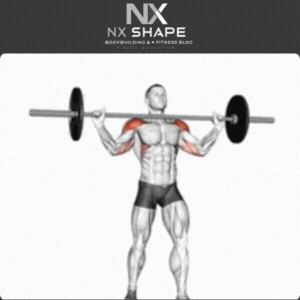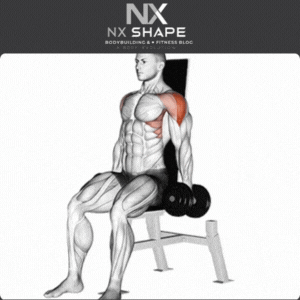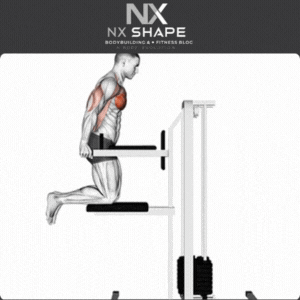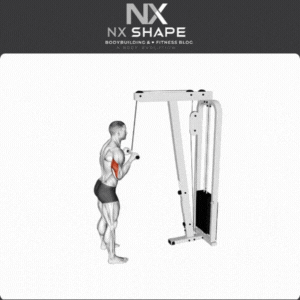To achieve optimal results, it is essential to design a training routine that effectively engages all muscle groups, promoting balanced strength and muscle development.
There are various routines that can be adapted to a person’s training level and needs.
This article will discuss push day, explain how this type of training works, and provide tips for including it in your training program.
It will also offer an example training program and advice for better results.
What is a push day workout?
Push-up training day is called this because the muscles that have the function of pushing are worked.
As is often the case, these muscles work together in most exercises.
The muscles worked in this type of training are the pectoralis major, deltoid (mainly the anterior region), triceps.
The main advantages of using this type of training are a greater balance in the muscles worked, a greater strengthening of the shoulder joint muscles and greater symmetry.
Push day vs Pullday key refferences
Push and pull training works the strength in the upper limbs in a more balanced way, as well as working the lower muscles.
The pulling muscles work different muscles to the pulling day.
On pull-up training day, the muscles worked are the back and biceps.
By balancing the volume between the two days, it’s possible to bring about a good balance in the physique and a greater gain in strength, generating a more harmonious and functional physique.
An example of how to adjust the two workouts is by alternating the two workouts and training the two workouts equally, so that in addition to the aesthetic effects of the workout, they are also important for avoiding injuries.
This routine can be used and adapted for beginners, intermediates, and advanced students. Depending on the person´s level, adjustments to the volume and intensity are necessary.
Best push exercises for chest, deltoids and tríceps

For this type of routine, it is necessary to use multi-joint exercises that target large muscle groups, as well as single-joint exercises that emphasise specific muscles.
The muscles in question can be best worked with the following exercises, according to this logic:
The best chest exercises on push-up day are:
Inclined bench press with dumbbells
The bench press is the main exercise for developing strength and muscle mass in the chest. The incline bench press variation with dumbbells works the pectoralis even more effectively because it allows for a greater range of motion, which is ideal for hypertrophy.
Peck deck
It is important to include this exercise in your training to emphasise the chest muscles more during your workout, thus increasing muscle fatigue and providing a greater stimulus.
The best shoulder exercises in this routine are:
Military Press

This exercise is an essential part of a training programme for anyone looking to build broad, strong shoulders. It also plays a key role in developing strength in the muscles used for pushing.
You can perform a variation of this exercise with dumbbells to work with a better range of motion and a lower load.
Additionally, you can adjust the movement to anatomically adapt the exercise to your joint’s comfort level.
Dumbbell Lateral raises

As the press works the deltoids more thoroughly, the dumbbell lateral raise will emphasise the lateral portion of the deltoid.
It is also possible to adapt this exercise to use a pulley, which increases time under tension in the muscle. This adaptation is also interesting from a hypertrophy point of view.
The best triceps exercises are:
Dips

This exercise primarily targets the chest, anterior deltoid and triceps, but is particularly effective for building triceps strength and muscle mass.
Those who lack the strength to perform this exercise with their own body weight can use the machine instead.
The machine allows you to adjust the load according to your strength level.
Triceps pulley

The goal of incorporating this exercise into a routine is to target the triceps without engaging other synergistic muscles.
As a reminder, different exercises can be used, depending on each person’s needs, and the amount can be adjusted according to each person’s training level.
If you have elbow pain, you can perform this exercise using a pulley and rope instead of a barbell.
Although the load will be slightly reduced, you will be able to use a greater range of motion than with a bar.
Sample push workout
Using the exercise examples above, we have created a training example for push day.
| Exercises | Sets | Reps | Rest |
| Inclined bench press with dumbbells | 4 | 6-8 | 120 seconds |
| Peck deck | 3 | 10-12 | 120 seconds |
| Military Press | 4 | 6-8 | 120 seconds |
| Dumbell lateral raises | 3 | 10-12 | 120 seconds |
| Parallel dips | 4 | 10 | 120 seconds |
| Triceps pulley | 3 | 10-12 | 120 seconds |
There are also different ways to complete this training throughout the week.
For example:
- Monday: Push Day
- Tuesday: Pull Day
- Wednesday: Legs
- Thursday: Rest
- Friday: Push
- Saturday: Pull
You can also Split your training program like this:
- Monday: Push/quads
- Tuesday: pull/hamstrings
- Wednesday: rest
- Thursday: push/quads
- Friday: pull/hamstrings
It’s worth remembering that the number of exercises, sets, repetitions and intervals need to be adjusted according to each person’s goals and conditioning.
Tips for better results
In order to get the best results from this routine, you need to pay attention to the following details
- Give priority to multi-joint exercises. These exercises work a large number of muscles and are responsible for increasing strength and hypertrophy gains.
Include these exercises in your workout to make it more efficient.
- Use single-joint exercises to complete the workout and emphasize the muscle more directly. Sometimes, multi-joint exercises alone are not enough to fully stimulate certain muscle groups.
Therefore, it is important to add exercises that work more emphatically in order to complete the muscle work and stimulate the muscles even more.
- Technique is the priority. There’s no point in abruptly increasing the weight if proper form is neglected.
Not only does this decrease the efficiency and stimulus responsible for gaining strength and hypertrophy, but it also increases the risk of injury.
Therefore, it is important to always prioritize technique in order to train safely.
- Gradually increase the training load. If you don’t want to plateau, it’s important to progressively increase the load.
You to challenge yourself in a controlled manner by increasing the volume and intensity of your training.
It´s possible to do this by increasing the number of repetitions, sets, range of motion, or load from one workout to the next.
- Take appropriate rest periods for better recovery. To improve your training performance and allow for adequate recovery between workouts, you need to rest properly between workouts.
When you exercise, you stimulate your muscles to grow bigger and stronger. However, it is during rest that overcompensation occurs, which is when your muscles grow.
Final considerations
A well-adjusted training routine is very important, as it allows you to work each muscle properly, provide good recovery and thus progress with the load in order to gain more muscle.
To do this, you need to adjust the training routine according to each person’s routine to make the training more efficient.
The push-up training day is an example of training that helps you produce balanced strength, symmetry and functionality.
For best results, ask your trainer for a safer and more efficient training routine


